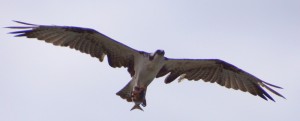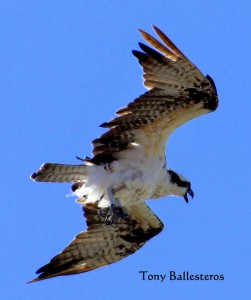 O.K., the “Lone Ranger” moniker for this great diurnal bird of prey found here in Puerto Peñasco is a personal reference based on one of the Osprey’s many unique physical characteristics: the black band that spans from its eyes and around its head resembling the mask worn by that iconic “masked man” of old. This skilled hunter is found on all continents except Antarctica, always near water, since 99% of its diet is fish
O.K., the “Lone Ranger” moniker for this great diurnal bird of prey found here in Puerto Peñasco is a personal reference based on one of the Osprey’s many unique physical characteristics: the black band that spans from its eyes and around its head resembling the mask worn by that iconic “masked man” of old. This skilled hunter is found on all continents except Antarctica, always near water, since 99% of its diet is fish
Although identified by some taxonomists with the bird family of hawks (Falconiformes), Ospreys are quite different in their taxonomy; so different in fact, that they’ve been assigned their own species (Pandion Haliaetus). Even though it does resemble a Hawk or small Eagle from a distance and is sometimes referred to as “Sea Hawk”, “Fish Hawk” or “Fish Eagle”, the Osprey is none of those, and wouldn’t approve of that comparison either because it’s a much more skilled angler than those birds.
Now for the cool facts that will hopefully have you watching for these creatures and enjoying them more:
- Ospreys have been recorded migrating up to 2,700 miles over a 13 day period. They live in the wild for 15 to 20 years although some have lived to over 30 years. They’ll log over 160,000 migration miles alone during their lifetime.
- As an aerial angler, the Osprey has several unique modifications to help it stay ahead of its strong competition. One is a sharp vision that allows it to see fish under water from as high as 130 feet, estimated to be about eight times stronger than human vision.
- When it spots a fish, the Osprey will hover in a spiral downward and dive feet first to lock the fish in its curved talons and fly
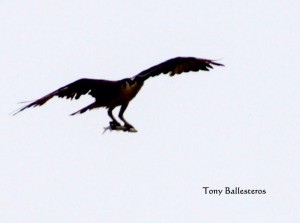 away, even pointing the fish head first to reduce wind resistance. It usually takes its catch back to the nest, although, as the photo indicates, sometimes the
away, even pointing the fish head first to reduce wind resistance. It usually takes its catch back to the nest, although, as the photo indicates, sometimes the 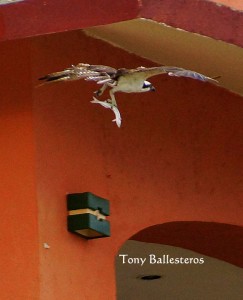 fish is so yummy the Osprey will just devour it from the closest place he can land, knowing his ability to catch another one.
fish is so yummy the Osprey will just devour it from the closest place he can land, knowing his ability to catch another one.
- Ospreys have long strong legs and feet, toes are of equal length, talons rounded and hooked rather than grooved and, most unusual and effective for fishing, is that the outer toe is reversible, allowing them to grasp a slippery fish with two toes in front and two toes behind. Their long legs help them grab fish under the surface of the water; their wings are long and broad like an Eagle’s wings which help them lift off after nabbing a fish.
 However, they have a limit of about 4 to 5 pounds if they want to be sure to get airborne with their catch. With anything heavier than that they risk the possibility of drowning. You may ask, why don’t they just drop the fish in those situations? Sometimes their curved talons and the backward facing scales on their feet prevent them from letting go of their prey, which will lead to drowning.
However, they have a limit of about 4 to 5 pounds if they want to be sure to get airborne with their catch. With anything heavier than that they risk the possibility of drowning. You may ask, why don’t they just drop the fish in those situations? Sometimes their curved talons and the backward facing scales on their feet prevent them from letting go of their prey, which will lead to drowning.
- Nevertheless, the Osprey is by far the best of all sea birds at the skill of fishing. So skilled, in fact that even American Bald Eagles will lurk on the sidelines waiting for the Osprey to make a catch then, being quite a bit larger than the Osprey, attack it causing it to drop its food. The Eagle will then catch the fish before it hits the water.
- In spite of the inherent risks mentioned above, the Osprey is a skilled aerial angler in a league with the Pelican, even though it can’t dive as deep. In several studies, Ospreys caught fish on at least 1 in every 4 dives with success rates as high as 70%. In these studies, the average time they spent hunting before making a catch was 12 minutes! Think about that next time you bait a hook!
- Osprey can make themselves a home on any tall structure: fork in a big tree, the top of telephone poles, power poles or other such structures. They build their nests with much creativity as well. They seem to use everything from twigs, sticks, driftwood, seaweed, even fish nets to build a huge nest far above the ground.
- Note: You can see a large nest here in Rocky Point at the top of an old sign pole in front of Kanachi’s across from the Fonatur
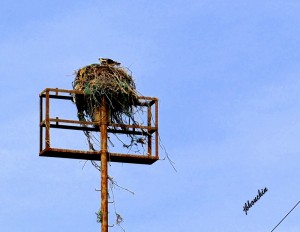 boat slips. You can watch an Osprey very early almost every morning fishing near the beach in front of the Sonoran Sea and Sonoran Spa Resort Condominiums. In fact, all these shots, except the one of the nest, were taken by photographer Tony Ballesteros from his balcony at the Sonoran Spa.
boat slips. You can watch an Osprey very early almost every morning fishing near the beach in front of the Sonoran Sea and Sonoran Spa Resort Condominiums. In fact, all these shots, except the one of the nest, were taken by photographer Tony Ballesteros from his balcony at the Sonoran Spa.
Hopefully, these facts have distinguished the Osprey from the other sea birds that frequent our beaches every day and have awakened your interest in watching for them by their unique fishing habits.
For more information about the Osprey go to:
http://en.wikipedia.org/wiki/Osprey or
http://animals.nationalgeographic.com/animals/birds/osprey or
http://www.about-falconry.com/osprey-bird.html
This blog is powered by the Sonoran Resorts Sales Group, Jim Ringquist, Director of Sales and Marketing.


